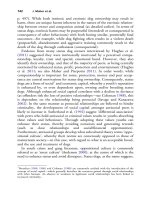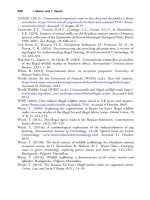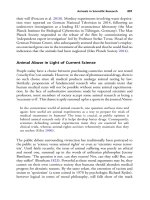The palgrave international handbook of a 111
Bạn đang xem bản rút gọn của tài liệu. Xem và tải ngay bản đầy đủ của tài liệu tại đây (28.45 KB, 1 trang )
Animal Neglect
101
Neglect as a Factor in Other Harms
In addition to its importance as a form of animal abuse in its own right,
non-human animal neglect can also be an indicator of other forms of
abuse (and vice versa) particularly spousal and child abuse. Linzey (2009)
identifies a link between animal abuse and human violence, building on
the work of other commentators who identified that animal abuse and
human violence are inextricably linked. Indeed non-human animal abuse
can be used as a tool to effect human control (Linzey 2009; Nurse 2013).
Accordingly, where one abuse occurs, the other is also likely to be present,
although Beirne (2004) identifies that there is no absolute progression
from animal to human abuse; thus the progression thesis often cited as
indicating animal abuse as a human abuse precursor (Farrington 2002) is
somewhat more complex than being a simple predictive link. Schaffner
also identifies that the link between individualised animal abuse and
human violence is an important factor in anti-cruelty legislation (2011,
p. 28) and in enforcement perspectives. Nurse (2013, p. 104) argues that
animal harm should not be seen in isolation but needs to be recognised ‘as
a form of abuse in its own right and as an indicator of antisocial behaviour
or violent tendencies in both adults and children that may be associated
with other forms of offending’. This being the case, neglect, where
identified or observed by animal professionals, needs to be recognised as
abuse, but also as indicative of other types of offending. For example,
Montoya and Miller (2009, p. 276) identify that ‘Colorado statutes
dictate that any veterinarian, officer of the state bureau of animal protection, or animal control officer must report any situation in which he or
she has reasonable cause to suspect that a child has been a victim of abuse
or neglect, or who has observed situations or circumstances that the
reporter believes would reasonably lead to abuse or neglect’.
Hawksworth and Balen (2009) recount the story of Family A, a case
example drawn from their experiences as part of a health visiting practice
in the UK. The family ‘consisted of two school-age children, one child
under five years, a mother, father, and uncle’ (2009, p. 283). Concerns
about the school-age children had been raised by educational staff
because of their dirty appearance, the persistent presence of head lice
and because they were becoming withdrawn. Health visitors, together
with the school nurse, visited the property following unsuccessful
attempts by school staff to gain entry. School staff had, however, noticed
a pit bull terrier tied up outside the home in a small garden ‘littered with









